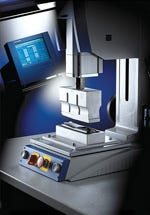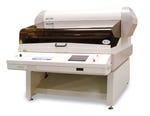Digital Ultrasonic Welder Defies Aging to Produce Consistent Welds
September 5, 2001
Originally Published MPMN September 2001
EQUIPMENT NEWS: Production and Assembly Equipment
Digital Ultrasonic Welder Defies Aging to Produce Consistent Welds
Device manufacturers require accurate production and assembly equipment to ensure the quality of their finished products. In this section, machines are described that meet the rigorous demands of the industry. Among them are ultrasonic welding systems that process signals digitally and an ionizer small enough to be mounted on end-of-arm tooling. An adhesives dispenser with a microprocessor, a video camera for motion analysis, and a versatile laser cutter are also featured.
|
Dynamic-series welders from Herrmann Ultrasonics use digital signal processing to allow calibration and maintain weld consistency. |
Ultrasonic welding systems for thermoplastics use fully digital signal processing to maintain consistent performance independent of component aging or temperature fluctuations. Unlike previous analog systems, the Dynamic-series welders from Herrmann Ultrasonics Inc. use computer numeric control to produce repeatable welds. "The main problem with other ultrasonic generators on the market is that their analog components are subject to aging and wear, producing inconsistent weld results," says executive vice president and general manager Dominic Friederich. "The output signals of our new digital generators, however, can be calibrated and remain consistent." The welders' closed-loop generator continuously monitors and adjusts the stack frequency to provide optimum efficiency. A square-column frame, an actuator with high-precision cross-roller bearings, and a computer-controlled proportional valve that maintains programmed welding forces also contribute to weld consistency.
Other features include an industrial PC controller with a touch screen that allows process visualization and parameter optimization, a self-check diagnostic system that minimizes downtime, and an indexed tooling system for fast changeovers. The units set up quickly and operate by means of a column hand crank and a ball pivot–supported fixturing plate. The welders also supply constant amplitude throughout the entire power range regardless of line voltage fluctuations.
Welding system is configurable for multiple tasks
A self-contained semiautomatic ultrasonic assembly platform from Branson Ultrasonics Corp. is configurable for welding, staking, inserting, and swaging thermoplastics. The standard Series-40 welding system includes one of the company's 900- or 2000-series ultrasonic welders, a Camco indexer, system controls, and a loading station. The indexer is available in sizes of 28 to 36 in., and has 4, 6, 8, 12, or 24 stops. Unit controls consist of an Allen Bradley PLC with a touch screen interface. Automatic cycling and air ejection keep the operator's hands free for loading. "Actual production rates depend upon the specific application, but speeds of 75 to 80 parts per minute are common, and rates of 120 parts per minute have been achieved in certain situations," says worldwide medical segment manager Michael Kan. The system can be expanded with the addition of multiple welders, leak testers, pick-and-place machinery, and printing equipment. Models using the 2000-series welder benefit from 1-millisecond parameter sampling and amplitude profiling that increases weld strength and reduces flash.
High-resolution video camera allows detailed motion analysis
|
MCT's Fastcam-Ultima 1024 camera features CMOS technology that allows small size and low power requirements. |
A high-speed, high-resolution video camera system is suited for motion analysis applications that require precise imaging data of mission-critical operations. Using CMOS technology, the Photron Fastcam-Ultima 1024 camera by MCT Inc. provides the necessary detail for troubleshooting and setup. "CMOS cameras have several benefits over CCD models," explains technical adviser Chris Balch. "They are highly integrated, resulting in lower power requirements and smaller size. CMOS cameras are also not susceptible to blooming." Blooming is glare caused by the excessive reflection of light off the object being photographed. Additionally, CMOS cameras benefit from a wide dynamic range that allows them to capture quality images in both light and dark areas.
The Photron camera has a resolution of 1024 x 1024 pixels at a rate of 500 frames per second. This frame rate can be easily changed, however, by reducing image size. The camera captures images at speeds of up to 16,000 images per second, each of which can be individually frozen. It also has the ability to electronically shutter in as little as 7.8 microseconds. Available in color or monochrome models, the camera comes as a stand-alone unit that transmits data via an IEEE 1394 FireWire or an SXGA monitor port. A computer-based version is also offered that inputs data directly through a PCI card. Up to 63 Photron cameras can be networked and synchronized from distances up to 2 km.
Compact ionizer eliminates static charges
An ionizer mounted on end-of-arm tooling eliminates static electricity at the point of production. Produced by JDV Products Inc., the Static Eraser ionizer electrically balances plastic parts and lenses with a blast of neutralizing air as they exit the mold. Measuring 38.6 x 92 x 55 mm, it is smaller than many conventional ionizing devices used in secondary operations. "The Static Eraser also has the benefit of being light and power efficient," explains sales and marketing manager Bill Richline. "Our unit weighs just 160 g and requires 24 V of power. Conventional machines often weigh 5 to 10 lb and need an electrical feed of 120 V." The Static Eraser ionizer has holes on four sides to allow mounting in many positions. The unit is UL and CE approved.
Custom assembly machines perform a range of operations
Machine systems for automated or semiautomated production, assembly, and testing are custom manufactured by Castle Engineering Company, Inc., to individual requirements. The versatile units can be designed to perform standard machining operations in conjunction with a range of assembly tasks, including welding, bonding, crimping, and staking. Inspection components can carry out a variety of mechanical, electrical, and pneumatic tests, such as product evaluation, sorting, life cycling, and x-ray imaging. Fully automatic plastic tubing cutters and coilers are also available.
Flexible laser cutter is compatible with many materials
|
Preco Industries' PL3143 laser cutting system can process plastics, acrylics, polyester films, rubber, paper, and foams. |
With a maximum cutting speed of 1000 mm/sec and an accuracy of ±0.1 mm, a Class 1 flatbed laser cutting system can be used on plastics, acrylics, polyester films, rubber, paper, and foams. The PL3143 system from Preco Industries Inc. uses a sealed CO2 laser with power configurations of 50, 100, or 250 W. The unit has a working area of 0.8 x 1.1 m, but maintains a compact footprint of 1.9 x 2.2 m. Z-axis travel spans 100 mm with repeatability of ±0.1 mm. The standard cutting head is equipped with a 2.5-in focal lens; a 5-in. lens is also available. Additionally, the motor is built into the machine to prevent crashes. The system comes with a complete software package capable of optimizing complex cutting paths. "This versatile system is suited for many medical applications, including drilling holes in catheters and titanium implants, cutting out hernia repair kits, and trimming and welding drapes and ostomy and IV bags," says marketing director Robin Barbero. Other possible applications include die-cutting adhesives, boards, switch membranes, flex circuits, flat-panel displays, filters, packaging, and catheters.
Cleanroom robots exhibit dexterity and speed
|
RX-series cleanroom robots from Stäubli Corp. offer detailed motion along six axes for performing high-precision tasks. |
Cleanroom robots from Stäubli Corp. have six axes of motion and large work envelopes to suit many medical applications. "The RX-series robots have humanlike dexterity with very high precision, making them suited for demanding tasks," says account manager Rick Palmer. The machines offer a repeatability of ±0.001 in. and rapid work speeds. Designed for cleanroom use, they emit one 0.035-µm particulate per cubic foot of air. Sample applications include handling, measuring, and filling IV bags and producing needles and syringes. Available in four models with eight reach options, the units increase safety and reduce contamination risks.
Washer cleans parts with holes and threads
Featuring gentle tumbling and rotation, a configurable multistage washer cleans parts using immersion sprays and eductor-induced turbulence. With wash, rinse, and blow-off stages, the Model-750 cleaning system by ADF Systems Ltd. is suited for parts with blind or internal holes, cavities, threads, or the tendency to nest. "This system is unique because it rotates the pieces, has a filtration package, and produces dry finished parts," says vice president Gerald Davis. The system has two stations and can clean two to four baskets per cycle without mixing parts. All processing parameters are controlled via a PLC and can be individually tailored for particular items. Stainless-steel construction provides years of reliable operation. A modular design allows configuration for specific applications. Oil skimmers, filters, and ultrasonic cleaners are offered as options.
Assembly systems use standardized chassis
Serving as an alternative to custom automation solutions, assembly systems from Mikron Corp. use a standardized chassis to minimize design requirements. While each of the Flexcell machines starts from a uniform base, they are flexible and can be modified to fit customer requirements. They also are designed so that automated operations can be supplemented by manual loading and other processes. Cycling up to 60 times per minute, the in-line systems offer cam- or CNC-controlled motions as needed. Other benefits include good efficiency, low life cycle costs, and short lead times.
Zachary Turke
Copyright ©2001 Medical Product Manufacturing News
You May Also Like






